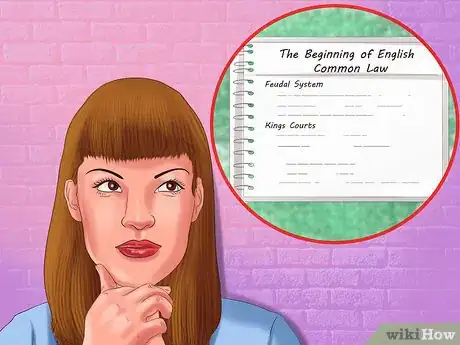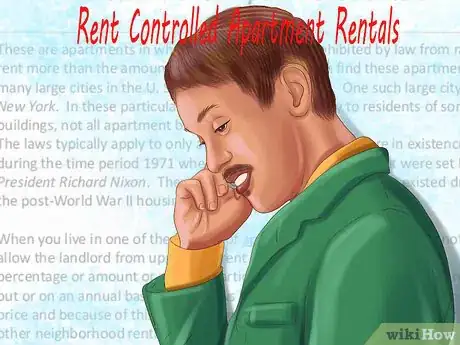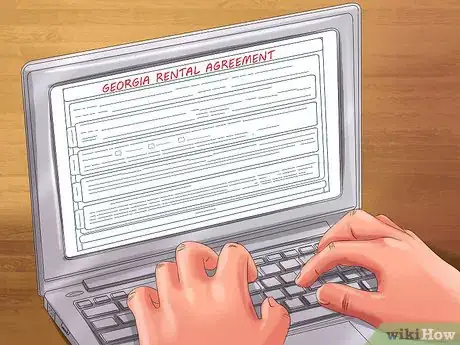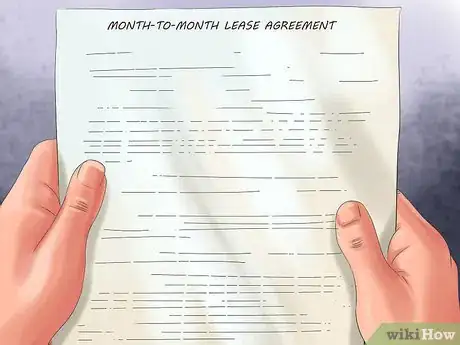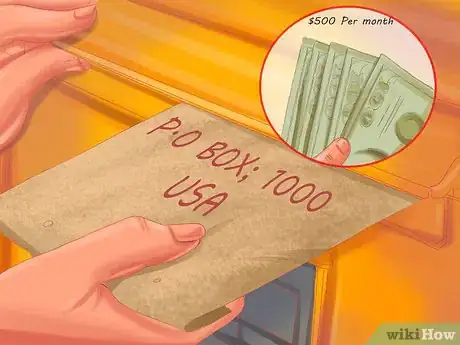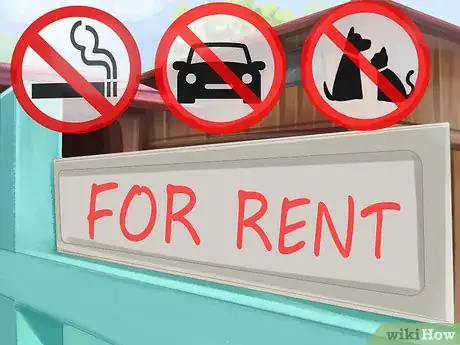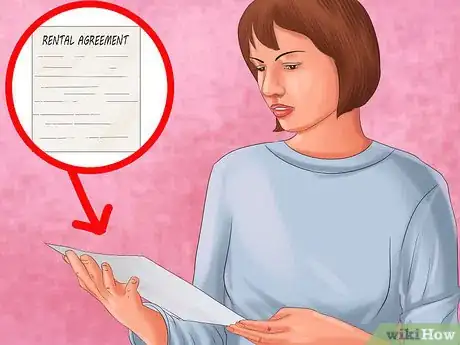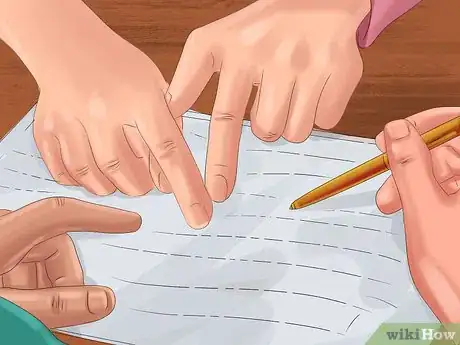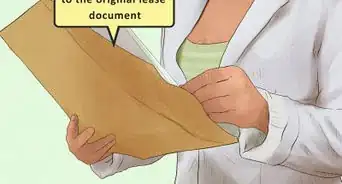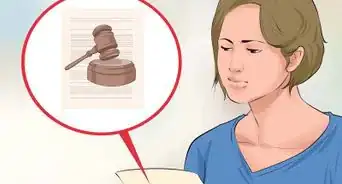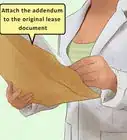This article was co-authored by Clinton M. Sandvick, JD, PhD. Clinton M. Sandvick worked as a civil litigator in California for over 7 years. He received his JD from the University of Wisconsin-Madison in 1998 and his PhD in American History from the University of Oregon in 2013.
There are 9 references cited in this article, which can be found at the bottom of the page.
This article has been viewed 52,850 times.
A rental agreement is a legal document that creates a short-term agreement between an owner and a renter. Although a rental agreement is sometimes used for equipment, it is most commonly created for a rental property. It is advisable that you have your rental agreement verified by a real estate lawyer, in part because of the wide variety of local and state laws relating to rental agreements. However, you do have the right to create a rental agreement on your own or in consultation with an attorney.
Steps
Researching State Laws
-
1Understand that there is no such thing as a standard rental agreement form in the USA. The simplest rental agreement can be a verbal agreement about the amount and due date of the rent to be paid in a month-to-month tenancy, with no formal contract between the renter and the landlord required. The open ended nature of what is legal is because landlord-tenant law is based on the feudal system of common law, and then each city, county, and state can have additional laws regarding rental agreements. There is the state "general-law" for small unincorporated townships and county areas concerning tenant and landlord relationships such as the procedures for evictions and such. The informal rental process may be under jurisdictions of municipal court, justice of the peace court and constables, and county district courts and sheriff, etc.[1]
- Nine states -- Alaska, Arizona, Kansas, Kentucky, Nebraska, New Mexico, Oregon, Virginia and Washington -- have enacted standardized residential landlord and tenant laws by following the recommendations of the Uniform Law Commission.
-
2Request a copy of local housing laws. Call your county courthouse to determine where you can pick up a renter's handbook or copies of applicable acts. You can also call your state housing office.
- Contact the state housing authority, which often puts together a book on the applicable laws. They may include things like Landlord/Tenant Acts, Asbestos Acts, Lead Paint Acts, Mobile Home Acts and Security Deposit Acts. Check to ensure the copy that you print or request is the most recent version.
Advertisement -
3Review health and safety laws. It is important to know the state and city regulations concerning asbestos, carbon monoxide, lead paint, and fire suppression systems before writing a rental agreement.
- Other issues include snow removal, pest removal, disposal of garbage and repairs, and liability for injuries sustained on the property.
- In some states such as California, tenants have the right to withhold rent if the property fails to meet health and safety laws.[2]
-
4
-
5Research laws concerning security deposits. Although many landlords require a security deposit equal to 1 or 2 months of rent, such deposits are also illegal in some areas.
- Regulations related to security deposits can also include how quickly and under what circumstances the deposit must be returned after the end of the rental agreement, and when the landlord may deduct funds from the security deposit to make repairs.[5]
Writing a Draft
-
1Search for templates online. Some states post standard rental agreements online. Do a search for your state and "rental agreement" on several search engines.
- States vary widely with regard to which department provides rental agreement templates. For example, the state of Georgia provides a sample rental agreement on its Department of Community Affairs website, while Massachusetts provides a sample through its Housing Consumer Education Center website.
- Do-it-yourself online law sites may offer guided tools to create a rental agreement appropriate for your location. You may be required to subscribe or pay a fee for access to documents created by lawyers in your state.
-
2Include information about the property. Describe the property that will be rented, the address, and the name and address of the property owner. If there will be a property manager who is different than the landlord, insert that information.
- You'll also need to include information about the renter, but you can leave blank lines where the information can be added to make the document more flexible.
-
3Describe the terms of the rental agreement. Include how many days of notice the landlord must receive in order to terminate the agreement.
- Rental agreements tend to be month-to-month. For a longer rental period, use a lease.
- For example, your rental agreement could state that "notice must be given in writing by either party at least 10 days before the end of the month in order to terminate the agreement."
-
4State the consequences if the lease is broken. Make sure this complies with local and state laws for eviction and/or termination of the agreement.[6]
- For example, the agreement may indicate that "The tenant may forfeit all or part of the security deposit for failure to pay rent, give proper notice, or fill out the full term of the agreement."
-
5Specify the payment, security deposit, and fee policy. State the ways that you will accept payment and where it should be delivered or sent.
- For example, the rental agreement could state that "The tenant agrees to rent the premises on a monthly basis at a rental rate of $500 per month, which will be payable by the 3rd day of each month by mail to Apartment Manager, P.O. Box 1001, Anywhere, USA."
- Most states require a grace period for paying rent. Define the late fees once that grace period has passed. For example, the agreement could state "A fee of $50 will be assessed for each day that the rent is not received beyond the due date and statutory grace period."
-
6Create a repair and maintenance policy. Tell the tenant exactly what process needs to be followed for necessary or requested improvements.
- Refer to local and state laws, which may indicate how quickly repairs must be made.
- For example, the agreement might state that the landlord agrees to maintain and repair the exterior, but that the tenant must maintain the condition of the interior of the rental property.
-
7Determine and specify additional/optional policies. These may include policies concerning pets, utilities, number of occupants, smoking, subletting, parking, and common area rules.
- There are many kinds of policies that can be added to a rental agreement. For example, the agreement could specify that "the tenant may not change or add any locks without the landlord's written consent, and that any such locks may be removed without notice."
- It is usually up to the landlord as to whether they will allow some pets, all pets, or no pets. If you want to allow pets and charge a pet deposit or pet rent, there may be applicable laws governing this practice.[7]
- Specify who will pay for utilities and whether specific providers must be used. You may also include whether and where satellite dishes may be mounted.
Finalizing the Agreement
-
1Consult a real estate lawyer. Because of the variations in local and state laws and the liability related to rental properties, it is prudent to have your rental agreement reviewed by a local lawyer prior to use.[8]
-
2Proofread your rental agreement. Avoid extra legal fees by making sure the document is as accurate and complete as possible before submitting it for review. For example, make sure there are places for you and the renter to sign and date the agreement. Leave spaces for more than 1 tenant to sign.
-
3Consider a hybrid solution. Create as much of the rental agreement as you feel comfortable doing on your own and then consider hiring a lawyer to add the most potentially problematic sections of the agreement, such as how disputes will be resolved.[9]
- You can save time by asking a lawyer to draw up your entire legal agreement. However, it will be less expensive to have the lawyer review and suggest changes to an existing document.
References
- ↑ http://www.nolo.com/legal-encyclopedia/free-books/renters-rights-book/chapter2-2.html
- ↑ http://www.nolo.com/legal-encyclopedia/california-tenant-rights-withhold-rent-repair-deduct.html
- ↑ http://www.nycrgb.org/html/resources/faq/rentcontrol.html
- ↑ http://dhcd.dc.gov/service/rent-control
- ↑ http://www.nolo.com/legal-encyclopedia/security-deposits
- ↑ http://www.nolo.com/legal-encyclopedia/evictions-terminations
- ↑ http://money.usnews.com/money/blogs/my-money/2013/07/17/how-much-should-you-pay-for-a-pet-deposit
- ↑ http://www.legalmatch.com/law-library/article/rental-agreement-lawyers.html
- ↑ http://www.nolo.com/legal-encyclopedia/resolving-landlord-tenant-disputes-faq-29141.html
